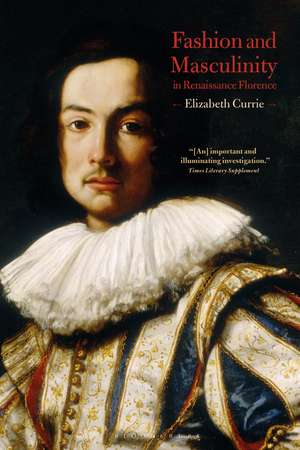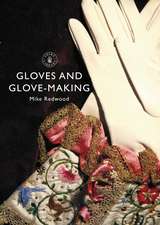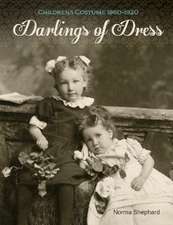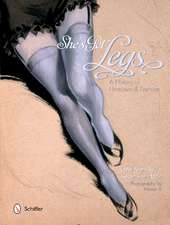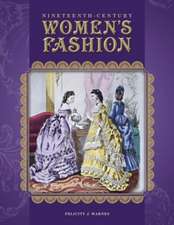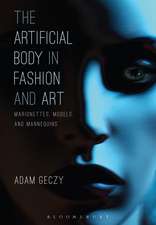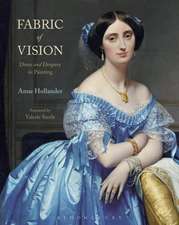Fashion and Masculinity in Renaissance Florence
Autor Elizabeth Currieen Limba Engleză Paperback – 25 dec 2019
| Toate formatele și edițiile | Preț | Express |
|---|---|---|
| Paperback (1) | 166.27 lei 3-5 săpt. | |
| Bloomsbury Publishing – 25 dec 2019 | 166.27 lei 3-5 săpt. | |
| Hardback (1) | 773.14 lei 6-8 săpt. | |
| Bloomsbury Publishing – 27 iul 2016 | 773.14 lei 6-8 săpt. |
Preț: 166.27 lei
Preț vechi: 215.67 lei
-23% Nou
Puncte Express: 249
Preț estimativ în valută:
31.82€ • 33.30$ • 26.48£
31.82€ • 33.30$ • 26.48£
Carte disponibilă
Livrare economică 11-25 martie
Preluare comenzi: 021 569.72.76
Specificații
ISBN-13: 9781350169982
ISBN-10: 1350169986
Pagini: 224
Ilustrații: 40 bw illus
Dimensiuni: 156 x 234 mm
Greutate: 0.36 kg
Editura: Bloomsbury Publishing
Colecția Bloomsbury Visual Arts
Locul publicării:London, United Kingdom
ISBN-10: 1350169986
Pagini: 224
Ilustrații: 40 bw illus
Dimensiuni: 156 x 234 mm
Greutate: 0.36 kg
Editura: Bloomsbury Publishing
Colecția Bloomsbury Visual Arts
Locul publicării:London, United Kingdom
Caracteristici
Analyses previously unpublished primary sources and archival materials, including surviving garments, portraiture and correspondence from the tailor's workshop to provide a new perspective on Italian fashion in the renaissance
Notă biografică
Elizabeth Currie is a lecturer and author specialising in the history of fashion and textiles. She was formerly a Research Fellow and Tutor in the History of Design at the Royal College of Art, UK and an Assistant Curator in the Furniture, Textiles and Fashion Department at the Victoria and Albert Museum, UK.
Cuprins
List of IllustrationsAcknowledgementsNotes on the TextIntroductionPart 1 Fashioning the Medici Court Chapter 1 The Court on Show Chapter 2 The Rise and Fall of the Florentine TogaPart 2 The Courtier as Consumer Chapter 3 The Noble Art of Shopping Chapter 4 Ruinous AppearancesPart 3 Modes of Masculinity Chapter 5 The Versatility of Black Chapter 6 Youth, Fashion, and Desire Chapter 7 Festive DressConclusionNotesBibliographyIndex
Recenzii
Important and illuminating ... Currie profitably mines the rich vein exposed by previous historians of clothing [and] makes expert use of contemporary written sources on fashion and etiquette ... [The book offers] so many riches and such careful analysis.
As far as fashion studies is concerned, it is too early to tell whether this excellent book will herald a seachange in the scholarly landscape - but one can certainly hope that it will.
This book opens up the wardrobes of elite Florentine families, showing how subtle and sophisticated the choice of dress could be in the sixteenth century. An intelligent, beautifully illustrated and original study, this is essential reading for anyone interested in how clothing "made the man" during the Renaissance. Highly recommended.
This insightful contribution turns a discerning and critical eye towards the clothing of sixteenth-century Florentine men. Currie skillfully explores the ways that clothing made the man within this emphatically sartorially literate society, and shows the rich, fundamental ways that power and identity were invariably "negotiated with a material reality" on elegantly dressed male bodies.
A brilliant analysis of men and the importance of dress in one of early modern Europe's fashion capitals. Readers will discover Florentine elite men as avid sartorialists propelled by their enthusiasm for new possibilities of materials and displays as much as by the intricate political and emotional games dress and accessories allowed them to play. Richly researched, this book represents a milestone in our knowledge of how sixteenth-century men conducted their lives through interacting with things.
Currie has written a highly detailed and meticulously researched volume ... [she] has done a masterful job in analysing the various influences and requirements for success in the Medici court.
Elizabeth Currie vividly captures the pleasures and perils of engaging with appearances for Florentine men of the sixteenth century. Recent work on the history of clothing has taught us much about sumptuary laws, courtly etiquette, and cultures of consumption in the period. Currie teaches us more, showing how the politics and materials of dress informed the very experience of men's lives, from political posturing in the lucco, through the reputational risks attached to balancing magnificence and sobriety, to the playful freedoms sought in eroticised youthful display and dressing for the homosocial pursuits of sport and carnival. Accessible and scholarly, Fashion and Masculinity in Renaissance Florence is a valuable addition to an expanding literature on sartorial histories.
Currie's book exemplifies the richness of the life history of materials, in the sense of fabrics made, decorated, and imbued with symbolic value. She brilliantly zeroes on particular public occasions and items of dress in Florence, such as the lucco, to open up the whole range of their political and cultural meanings.
As far as fashion studies is concerned, it is too early to tell whether this excellent book will herald a seachange in the scholarly landscape - but one can certainly hope that it will.
This book opens up the wardrobes of elite Florentine families, showing how subtle and sophisticated the choice of dress could be in the sixteenth century. An intelligent, beautifully illustrated and original study, this is essential reading for anyone interested in how clothing "made the man" during the Renaissance. Highly recommended.
This insightful contribution turns a discerning and critical eye towards the clothing of sixteenth-century Florentine men. Currie skillfully explores the ways that clothing made the man within this emphatically sartorially literate society, and shows the rich, fundamental ways that power and identity were invariably "negotiated with a material reality" on elegantly dressed male bodies.
A brilliant analysis of men and the importance of dress in one of early modern Europe's fashion capitals. Readers will discover Florentine elite men as avid sartorialists propelled by their enthusiasm for new possibilities of materials and displays as much as by the intricate political and emotional games dress and accessories allowed them to play. Richly researched, this book represents a milestone in our knowledge of how sixteenth-century men conducted their lives through interacting with things.
Currie has written a highly detailed and meticulously researched volume ... [she] has done a masterful job in analysing the various influences and requirements for success in the Medici court.
Elizabeth Currie vividly captures the pleasures and perils of engaging with appearances for Florentine men of the sixteenth century. Recent work on the history of clothing has taught us much about sumptuary laws, courtly etiquette, and cultures of consumption in the period. Currie teaches us more, showing how the politics and materials of dress informed the very experience of men's lives, from political posturing in the lucco, through the reputational risks attached to balancing magnificence and sobriety, to the playful freedoms sought in eroticised youthful display and dressing for the homosocial pursuits of sport and carnival. Accessible and scholarly, Fashion and Masculinity in Renaissance Florence is a valuable addition to an expanding literature on sartorial histories.
Currie's book exemplifies the richness of the life history of materials, in the sense of fabrics made, decorated, and imbued with symbolic value. She brilliantly zeroes on particular public occasions and items of dress in Florence, such as the lucco, to open up the whole range of their political and cultural meanings.
